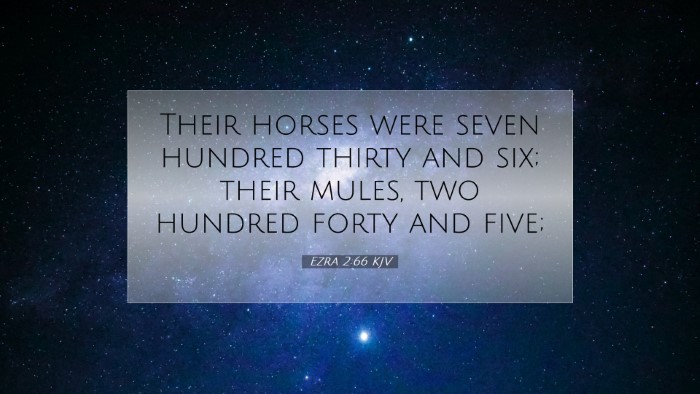Commentary on Ezra 2:66
Ezra 2:66 presents an important enumeration of those who returned from Babylonian exile to Jerusalem. This verse exemplifies the exilic community's desire to restore their identity and worship. It serves as a key text in understanding the historical, spiritual, and sociological dimensions of the post-exilic community. The commentary draws from the insights of prominent public domain scholars like Matthew Henry, Albert Barnes, and Adam Clarke.
Historical Context
In the post-exilic period, the Jewish people found themselves in a new landscape—politically, culturally, and spiritually. The return under Zerubbabel marked a significant shift from exile to restoration. As the group returned, it was crucial to establish their connection to the past to lay the foundation for rebuilding their society. Ezra 2:66 articulates the population of those returning, emphasizing not just numbers but the symbolic significance of regeneration.
Matthew Henry’s Insights
Matthew Henry emphasizes the gravity of this return. He notes that the numbered lists reflect a common practice of recording genealogies, which was crucial for the Jewish identity. The returning exiles were conscious of their heritage, ensuring that the names of those who had suffered in exile were preserved. Henry points out that this return was not merely a physical relocation but a spiritual resurrection, where the people aimed to rekindle their covenantal relationship with God.
Albert Barnes' Contributions
Albert Barnes provides additional depth to the analysis by elaborating on the significance of the number mentioned in Ezra 2:66. He remarks that the total number of returnees—over 42,000—indicates a renewed hope and vitality within the Jewish community. Barnes underscores that this restoration was driven by God’s providential hand, as prophesied by Jeremiah and Isaiah. He also notes that the mention of families and their origins illustrates the theological concept of remnant theology, which speaks to God preserving a people for Himself despite widespread disobedience.
Adam Clarke’s Commentary
Adam Clarke approaches the text with a focus on its practical implications for contemporary readers. He highlights that the narrative serves to remind the faithful of God’s enduring promises and the importance of communal identity. Clarke notes the various families named, showing the continuity of social structures even after the devastating effects of exile. Furthermore, he discusses how the rebuilding effort included both spiritual and physical components, with the returnees not only resettling lands but also reigniting the worship of God.
Theological Implications
The enumeration of the returnees in Ezra 2:66 calls attention to God's faithfulness in fulfilling His promises to restore Jerusalem and His people. This return symbolizes a new beginning, where the community recognizes their past failures but is challenged to move forward with renewed faith. Theologically, it invites reflection on God’s sovereign ability to bring renewal, as well as the human response required to participate in that renewal.
- Identity and Heritage: The return to Jerusalem represents a reclamation of identity. Both Matthew Henry and Albert Barnes articulate how understanding one's lineage helps bolster communal resilience.
- Divine Providence: All scholars underline the aspect of divine guidance in the return. The returnees' march towards Jerusalem was not an isolated event but part of God’s overarching plan for redemption.
- Restoration with Purpose: Adam Clarke emphasizes that the collective effort of returning served a dual purpose—physical restoration and spiritual revival. This was not merely about rebuilding walls but re-establishing a relationship with God.
Practical Applications
For pastors, students, and theologians, Ezra 2:66 holds practical implications for understanding community, identity, and worship. Here are some applications drawn from the commentaries:
- Community Engagement: The importance of knowing who we are as a community in Christ should be paramount. Just as the exiles were reconnected to their ancestry, contemporary faith communities must also recognize their roots and live them out.
- Faithfulness amid Adversity: The narrative encourages believers to remain faithful even amid trials. The context of returning from exile to a seemingly inhospitable land serves as a powerful metaphor for persevering through difficulties.
- Active Participation in God’s Plan: Each individual played a role in the return. Church leaders must inspire congregations to recognize their unique roles within the larger mission of God, promoting an active rather than passive faith.
Conclusion
In conclusion, Ezra 2:66 is more than a mere list of names and numbers; it encapsulates the essence of hope, restoration, and divine faithfulness. As highlighted by the insights of Matthew Henry, Albert Barnes, and Adam Clarke, the return from exile is a foundational moment in Jewish history that carries significant theological weight. It challenges today's faithful to reflect upon their own journey of restoration, identity, and community in their walk with God.


